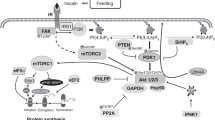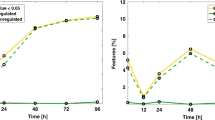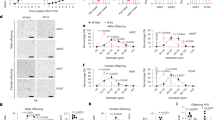Abstract
We seek to understand the mechanism for the delayed postnatal switch between glycolytic and oxidative metabolism in preterm newborns. Our previous study [Brauner et al. (Pediatr Res 53: 691-697, 2003)] suggested impaired postnatal recruitment of the gene for mitochondrial uncoupling protein 3 (UCP3) by nutritional lipids in skeletal muscle of neonates delivered before approximately 26 wk of gestation. UCP3 is linked to lipid oxidation and may be involved in the defective development of energy metabolism in skeletal muscles of very preterm newborns. In extension of our previous study, autopsy samples of musculus quadriceps femoris from 40 mostly preterm neonates and 5 fetuses were used for quantification of transcripts for UCP3, GLUT4, and their transcriptional regulator, AMP-activated protein kinase (AMPK). The new analysis confirmed the defect in the recruitment of the UCP3 gene expression by lipids in very preterm neonates. It also suggested involvement of AMPK in the control of expression of both metabolic genes, UCP3 and GLUT4, in the skeletal muscle of the newborns. Experiments on adult C57BL/6J mice confirmed the relationships between the transcripts and supported the involvement of AMPK in the control of UCP3 gene expression.
Similar content being viewed by others
Log in or create a free account to read this content
Gain free access to this article, as well as selected content from this journal and more on nature.com
or
Abbreviations
- AMPK:
-
AMP-activated protein kinase
- α2-AMPK:
-
α2-subunit of AMP-activated protein kinase
- α2-KO:
-
whole-body knockout of α2-subunit of AMP-activated protein kinase
- EF-1α:
-
elongation factor 1α
- FA:
-
fatty acids
- LCP:
-
long-chain polyunsaturated fatty acids
- qRT-PCR:
-
real-time quantitative PCR
- T3:
-
3,5,3′-triiodothyronine
- UCP3:
-
uncoupling protein 3
References
Izquierdo JM, Luis AM, Cuezva JM 1990 Postnatal mitochondrial differentiation in rat liver. J Biol Chem 265: 9090–9097
Schonfeld P, Schild L, Bohnensack R 1996 Expression of the ADP/ATP carrier and expansion of the mitochondrial (ATP + ADP) pool contribute to postnatal maturation of the rat heart. Eur J Biochem 241: 895–900
Schagger H, Noack H, Halangk W, Brandt U, Von Jagow G 1995 Cytochrome-c oxidase in developing rat heart. Enzymic properties and amino-terminal sequences suggest identity of the fetal heart and the adult liver isoform. Eur J Biochem 230: 235–241
Valcarce C, Izquierdo JM, Chamorro M, Cuezva JM 1994 Mammalian adaptation to extrauterine environment: mitochondrial functional impairment caused by prematurity. Biochem J 303: 855–862
Sperl W, Sengers RC, Trijbels JM, Ruitenbeek W, Doesburg WH, Smeitink JA, Kollee LA, Boon JM 1992 Enzyme activities of the mitochondrial energy generating system in skeletal muscle tissue of preterm and fullterm neonates. Ann Clin Biochem 29: 638–645
Brauner P, Kopecky P, Flachs P, Ruffer J, Sebron V, Plavka R, Vitkova I, Vorlicek J, Kopecky J 2003 Induction of uncoupling protein 3 gene expression in skeletal muscle of preterm newborns. Pediatr Res 53: 691–697
Weigle DS, Selfridge LE, Schwartz MW, Seeley RJ, Cummings DE, Havel PJ, Kuijper JL, BeltrandelRio H 1998 Elevated free fatty acids induce uncoupling protein 3 expression in muscle: a potential explanation for the effect of fasting. Diabetes 47: 298–302
Brun S, Carmona MC, Mampel T, Vinas O, Giralt M, Iglesias R, Villarroya F 1999 Uncoupling protein-3 gene expression in skeletal muscle during development is regulated by nutritional factors that alter circulating non-esterified fatty acids. FEBS Lett 453: 205–209
Cline GW, Vidal-Puig AJ, Dufour S, Cadman KS, Lowell BB, Shulman GI 2001 In vivo effects of uncoupling protein-3 gene disruption on mitochondrial energy metabolism. J Biol Chem 276: 20240–20244
Samec S, Seydoux J, Dulloo AG 1998 Role of UCP homologues in skeletal muscles and brown adipose tissue: mediators of thermogenesis or regulators of lipids as fuel substrates?. FASEB J 12: 715–724
Garcia-Martinez C, Sibille B, Solanes G, Darimont C, Mace K, Villarroya F, Gomez-Foix AM 2001 Overexpression of UCP3 in cultured human muscle lowers mitochondrial membrane potential, raises ATP/ADP ratio, and favors fatty acid versus glucose oxidation. FASEB J 15: 2033–2035
Himms-Hagen J, Harper ME 2001 Physiological role of UCP3 may be export of fatty acids from mitochondria when fatty acid oxidation predominates: an hypothesis. Exp Biol Med (Maywood) 226: 78–84
Cadenas S, Buckingham JA, Samec S, Seydoux J, Din N, Dulloo AG, Brand MD 1999 UCP2 and UCP3 rise in starved rat skeletal muscle but mitochondrial proton conductance is unchanged. FEBS Lett 462: 257–260
Clapham JC, Coulthard VH, Moore GB 2001 Concordant mRNA expression of UCP-3, but not UCP-2, with mitochondrial thioesterase-1 in brown adipose tissue and skeletal muscle in db/db diabetic mice. Biochem Biophys Res Commun 287: 1058–1062
Echtay KS, Roussel D, St Pierre J, Jekabsons MB, Cadenas S, Stuart JA, Harper JA, Roebuck SJ, Morrison A, Pickering S, Clapham JC, Brand MD 2002 Superoxide activates mitochondrial uncoupling proteins. Nature 415: 96–99
Esterbauer H, Oberkofler H, Krempler F, Strosberg AD, Patsch W 2000 The uncoupling protein-3 gene is transcribed from tissue-specific promoters in humans but not in rodents. J Biol Chem 275: 36394–36399
Brun S, Carmona MC, Mampel T, Vinas O, Giralt M, Iglesias R, Villarroya F 1999 Activators of peroxisome proliferator-activated receptor-a induce the expression of the uncoupling protein-3 gene in skeletal muscle. Diabetes 48: 1217–1222
Young ME, Patil S, Ying J, Depre C, Ahuja HS, Shipley GL, Stepkowski SM, Davies PJ, Taegtmeyer H 2001 Uncoupling protein 3 transcription is regulated by peroxisome proliferator-activated receptor (alpha) in the adult rodent heart. FASEB J 15: 833–845
Solanes G, Pedraza N, Iglesias R, Giralt M, Villarroya F 2000 The human uncoupling protein-3 gene promoter requires MyoD and is induced by retinoic acid in muscle cells. FASEB J 14: 2141–2143
Gong DW, He Y, Karas M, Reitman M 1997 Uncoupling protein-3 is a mediator of thermogenesis regulated by thyroid hormone, beta3-adrenergic agonists, and leptin. J Biol Chem 272: 24129–24132
Hardie DG 2004 The AMP-activated protein kinase pathway - new players upstream and downstream. J Cell Sci 117: 5479–5487
Hayashi T, Hirshman MF, Kurth EJ, Winder WW, Goodyear LJ 1998 Evidence for 5′ AMP-activated protein kinase mediation of the effect of muscle contraction on glucose transport. Diabetes 47: 1369–1373
Winder WW, Hardie DG 1996 Inactivation of acetyl-CoA carboxylase and activation of AMP-activated protein kinase in muscle during exercise. Am J Physiol 270: E299–E304
Winder WW, Holmes BF, Rubink DS, Jensen EB, Chen M, Holloszy JO 2000 Activation of AMP-activated protein kinase increases mitochondrial enzymes in skeletal muscle. J Appl Physiol 88: 2219–2226
Zhou M, Lin BZ, Coughlin S, Vallega G, Pilch PF 2000 UCP-3 expression in skeletal muscle: effects of exercise, hypoxia, and AMP-activated protein kinase. Am J Physiol Endocrinol Metab 279: E622–E629
Pedersen SB, Lund S, Buhl ES, Richelsen B 2001 Insulin and contraction directly stimulate UCP2 and UCP3 mRNA expression in rat skeletal muscle in vitro. Biochem Biophys Res Commun 283: 19–25
Stoppani J, Hildebrandt AL, Sakamoto K, Cameron-Smith D, Goodyear LJ, Neufer PD 2002 AMP-activated protein kinase activates transcription of the UCP3 and HKII genes in rat skeletal muscle. Am J Physiol Endocrinol Metab 283: E1239–E1248
Suwa M, Nakano H, Kumagai S 2003 Effects of chronic AICAR treatment on fiber composition, enzyme activity, UCP3, and PGC-1 in rat muscles. J Appl Physiol 95: 960–968
Jorgensen SB, Wojtaszewski JF, Viollet B, Andreelli F, Birk JB, Hellsten Y, Schjerling P, Vaulont S, Neufer PD, Richter EA, Pilegaard H 2005 Effects of alpha-AMPK knockout on exercise-induced gene activation in mouse skeletal muscle. FASEB J 19: 1146–1148
Long YC, Barnes BR, Mahlapuu M, Steiler TL, Martinsson S, Leng Y, Wallberg-Henriksson H, Andersson L, Zierath JR 2005 Role of AMP-activated protein kinase in the coordinated expression of genes controlling glucose and lipid metabolism in mouse white skeletal muscle. Diabetologia 48: 2354–2364
Makinde AO, Gamble J, Lopaschuk GD 1997 Upregulation of 5′-AMP-activated protein kinase is responsible for the increase in myocardial fatty acid oxidation rates following birth in the newborn rabbit. Circ Res 80: 482–489
Hardie DG, Carling D, Carlson M 1998 The AMP-activated/SNF1 protein kinase subfamily: metabolic sensors of the eukaryotic cell?. Annu Rev Biochem 67: 821–855
Martin JC, Niyongabo T, Moreau L, Antoine JM, Lanson M, Berger C, Lamisse F, Bougnoux P, Couet C 1991 Essential fatty acid composition of human colostrum triglycerides: its relationship with adipose tissue composition. Am J Clin Nutr 54: 829–835
Pavelka S, Kopecky P, Bendlova B, Stolba P, Vitkova I, Vobruba V, Plavka R, Houstek J, Kopecky J 1997 Tissue metabolism and plasma levels of thyroid hormones in critically ill very premature infants. Pediatr Res 42: 812–818
Brauner P, Nibbelink M, Flachs P, Vitkova I, Kopecky P, Mertelikova I, Janderova L, Penicaud L, Casteilla L, Plavka R, Kopecky J 2001 Fast decline of hematopoiesis and uncoupling protein 2 content in human liver after birth: location of the protein in Kupffer cells. Pediatr Res 49: 440–447
Viollet B, Andreelli F, Jorgensen SB, Perrin C, Geloen A, Flamez D, Mu J, Lenzner C, Baud O, Bennoun M, Gomas E, Nicolas G, Wojtaszewski JF, Kahn A, Carling D, Schuit FC, Birnbaum MJ, Richter EA, Burcelin R, Vaulont S 2003 The AMP-activated protein kinase alpha2 catalytic subunit controls whole-body insulin sensitivity. J Clin Invest 111: 91–98
Baillie RA, Takada RA, Nakamura M, Clarke SD 1999 Coordinate induction of peroxisomal acyl-CoA oxidase and UCP-3 by dietary fish oil: a mechanism for decreased body fat deposition. Prostaglandins Leukot Essent Fatty Acids 60: 351–356
Herrera E, Amusquivar E 2000 Lipid metabolism in the fetus and the newborn. Diabetes Metab Res Rev 16: 202–210
Bateson P, Barker D, Clutton-Brock T, Deb D, D'Udine B, Foley RA, Gluckman P, Godfrey K, Kirkwood T, Lahr MM, McNamara J, Metcalfe NB, Monaghan P, Spencer HG, Sultan SE 2004 Developmental plasticity and human health. Nature 430: 419–421
Rodriquez- Palmero M, Koletzko B, Kunz C, Jensen R 1999 Nutritional and biochemical properties of human mikl: II Lipids, micronutrients, and bioactive factors. Clin Perinatol 26: 335–359
Arenz S, Ruckerl R, Koletzko B, Von Kries R 2004 Breast-feeding and childhood obesity - a systematic review. Int J Obes Relat Metab Disord 28: 1247–1256
Young TK, Martens PJ, Taback SP, Sellers EA, Dean HJ, Cheang M, Flett B 2002 Type 2 diabetes mellitus in children: prenatal and early infancy risk factors among Native Canadians. Arch Pediatr Adolesc Med 156: 651–655
Hofman PL, Regan F, Jackson WE, Jefferies C, Knight DB, Robinson EM, Cutfield WS 2004 Premature birth and later insulin resistance. N Engl J Med 351: 2179–2186
Petersen KF, Befroy D, Dufour S, Dziura J, Ariyan C, Rothman DL, DiPietro L, Cline GW, Shulman GI 2003 Mitochondrial dysfunction in the elderly: possible role in insulin resistance. Science 300: 1140–1142
Schrauwen P, Hesselink MK, Blaak EE, Borghouts LB, Schaart G, Saris WH, Keizer HA 2001 Uncoupling protein 3 content is decreased in skeletal muscle of patients with type 2 diabetes. Diabetes 50: 2870–2873
Acknowledgements
The authors thank to Prof. Arnost Kotyk for critical reading of the manuscript, and Jaroslava Bemova, Sona Hornova, and Daniela Salkova for technical assistance.
Author information
Authors and Affiliations
Corresponding author
Additional information
Supported by the Internal Grant Agency of the Ministry of Health of the Czech Republic (grant NE/6430-5), the European Commission (LSHM-CT-2004-005272 and FOOD-CT-2005-007036) and the Barrande - Czech and French integrated program (2-06-32).
Rights and permissions
About this article
Cite this article
Brauner, P., Kopecky, P., Flachs, P. et al. Expression of Uncoupling Protein 3 and GLUT4 Gene in Skeletal Muscle of Preterm Newborns: Possible Control by AMP-Activated Protein Kinase. Pediatr Res 60, 569–575 (2006). https://doi.org/10.1203/01.PDR.0000242301.64555.e2
Received:
Accepted:
Issue date:
DOI: https://doi.org/10.1203/01.PDR.0000242301.64555.e2
This article is cited by
-
Postnatal induction of muscle fatty acid oxidation in mice differing in propensity to obesity: a role of pyruvate dehydrogenase
International Journal of Obesity (2020)
-
Possible counter effect in newborns of 1936A>G (I646V) polymorphism in the AKAP10 gene encoding A-kinase-anchoring protein 10
Journal of Perinatology (2012)



